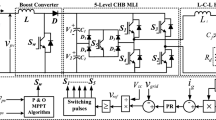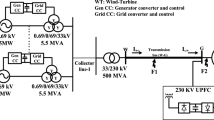Abstract
Wind power capacity has received enormous growth during past decades. With substantial development of wind power, it is expected to provide a fifth of world’s electricity by the end of 2030. In wind energy conversion system, the power electronic converters play an important role. This paper presents the two level and matrix converters performance in wind energy conversion system employing Doubly Fed Induction Generator (DFIG). The DFIG is a wound rotor induction generator. Because of the advantages of the DFIG over other generators it is being used for most of the wind applications. This paper also discusses control of converters using the space vector pulse width modulation technique. The MATLAB/SIMULINK® software is used to study the performance of the converters.


















Similar content being viewed by others
References
R.D. Shukla, A. Singh, S.P. Singh, Generators for variable speed wind energy conversion systems: A comparative study. IJESCC 3(2), 103–117 (2012)
M. Pattnaik, Study of Doubly-Fed induction generator for variable speed wind energy conversion systems. Int. J. Power Syst. Oper. Energy Manag. 1(3), 2231–4407 (2012)
Z. Chen, J.M. Guerrero, F. Blaabjerg, A review of the state of the art of power electronics for wind turbines. IEEE Trans. Power Electron. 24(8), 1859–1875 (2009)
F. Blaabjerg, M. Liserre, K. Ma, Power electronics converters for wind turbine systems. IEEE Trans. Ind. Appl. 48(2), 708–719 (2012)
J.G. Slootweg, H. Polinder, W.L. Kling, Dynamic modelling of a wind turbine with doubly fed induction generator. 0-7803-7173-9/01/$10.00 © 2001 IEEE
Jing X, Modeling and control of a doubly-fed induction generator for wind turbine-generator systems. Marquette University e-Publications Theses (2009)
P. Singh, G. Sharma, S. Prasher, Power control of DFIG using back to back converters. Int. J. Eng. Innov. Technol. 3(3), 196–200 (2013)
P.W. Wheeler, J. Rodríguez, J.C. Clare, L. Empringham, A. Weinstein, Matrix converters: A technology review. IEEE Trans. Ind. Electron. 49(2), 276–288 (2002)
K.V. Kumar, P.A. Michael, J.P. John, S.S. Kumar, Simulation and comparison of SPWM and SVPWM control for three phase inverter. ARPN J. Eng. Appl. Sci. 5(7), 61–74 (2010)
L. Komma, R. Vasa, Simulation and comparison of three level inverter using SVPWM & SPWM. Int. J. Electr. Electron. Res. 2(3), 21–30 (2014)
R. Ghoni, A.N. Abdalla, Analysis and mathematical modelling of space vector modulated direct controlled matrix converter. J. Theor. Appl. Inf. Technol. (2010)
M. Rameshkumar, Y. Sreenivasa Rao, A. Jaya laxmi, Modulation and control techniques of matrix converter. Int. J. Adv. Eng. Technol. ISSN: 2231-1963 (2012)
Acknowledgements
Authors are grateful to Jawaharlal Nehru Technological University, Anantapur for funding the research work.
Author information
Authors and Affiliations
Corresponding author
Rights and permissions
About this article
Cite this article
Reddy, G.P.R., Kumar, M.V. Two Level Versus Matrix Converters Performance in Wind Energy Conversion Systems Employing DFIG. J. Inst. Eng. India Ser. B 98, 503–515 (2017). https://doi.org/10.1007/s40031-017-0277-5
Received:
Accepted:
Published:
Issue Date:
DOI: https://doi.org/10.1007/s40031-017-0277-5




